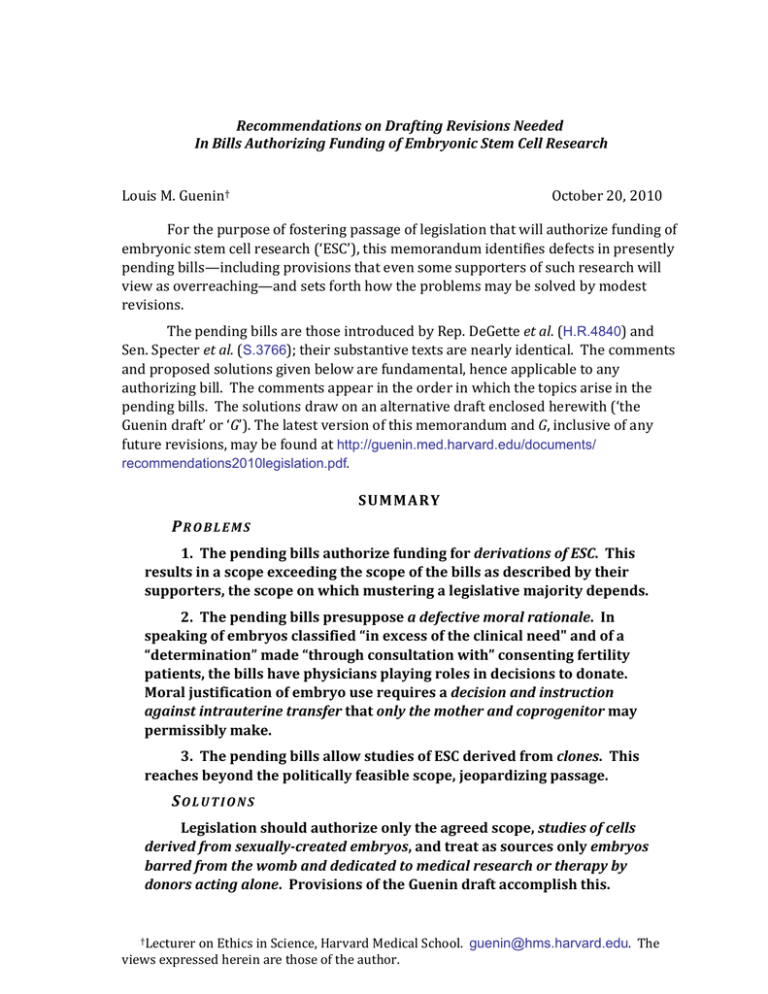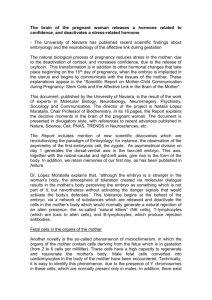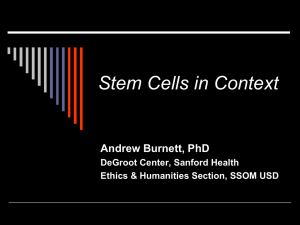Recommendations on Drafting Revisions Needed
advertisement

Recommendations on Drafting Revisions Needed In Bills Authorizing Funding of Embryonic Stem Cell Research Louis M. Guenin† October 20, 2010 For the purpose of fostering passage of legislation that will authorize funding of embryonic stem cell research (‘ESC’), this memorandum identifies defects in presently pending bills—including provisions that even some supporters of such research will view as overreaching—and sets forth how the problems may be solved by modest revisions. The pending bills are those introduced by Rep. DeGette et al. (H.R.4840) and Sen. Specter et al. (S.3766); their substantive texts are nearly identical. The comments and proposed solutions given below are fundamental, hence applicable to any authorizing bill. The comments appear in the order in which the topics arise in the pending bills. The solutions draw on an alternative draft enclosed herewith (‘the Guenin draft’ or ‘G’). The latest version of this memorandum and G, inclusive of any future revisions, may be found at http://guenin.med.harvard.edu/documents/ recommendations2010legislation.pdf. SUMMARY PROBLEMS 1. The pending bills authorize funding for derivations of ESC. This results in a scope exceeding the scope of the bills as described by their supporters, the scope on which mustering a legislative majority depends. 2. The pending bills presuppose a defective moral rationale. In speaking of embryos classified “in excess of the clinical need" and of a “determination” made “through consultation with” consenting fertility patients, the bills have physicians playing roles in decisions to donate. Moral justification of embryo use requires a decision and instruction against intrauterine transfer that only the mother and coprogenitor may permissibly make. 3. The pending bills allow studies of ESC derived from clones. This reaches beyond the politically feasible scope, jeopardizing passage. SOLUTIONS Legislation should authorize only the agreed scope, studies of cells derived from sexually-created embryos, and treat as sources only embryos barred from the womb and dedicated to medical research or therapy by donors acting alone. Provisions of the Guenin draft accomplish this. Lecturer on Ethics in Science, Harvard Medical School. guenin@hms.harvard.edu. The views expressed herein are those of the author. † 2 DETAILS 1. The authorized scope should exclude funding for derivations 1.1 Members of Congress have consistently claimed that recent bills authorizing funding for use of ESC exclude funding for derivations. 1 Such exclusion constitutes part of the cornerstone of the present legislative majority. 1.2 The pending bills' authorized scope is “research that utilizes . . . human embryonic stem cells” (H.R. 4804, 2:15–18; S. 3766, 2:13–20). 2 In practice, ESC research includes the derivation of ESC. In the absence of any exclusion of derivations in the bills, the authorized scope includes derivations. 1.2[a] In floor debate, opponents may declare, “These bills allow funds to be spent on killing embryos. Their sponsors, in claiming otherwise, misrepresent the content of their bills.” 1.2[b] This attack would likely sway many members who decided to support ESC research on the understanding that the government would not directly fund embryo sacrifice. 1.3 Upon learning of this inadvertent overbreadth, several notions have been or might be broached in attempting to suggest that an exclusion might not be needed. None of these notions avails. 1.3[a] It has been suggested that future reenactment of the Dickey Amendment (‘DA’) would modify authority for funding studies of ESC by imposing an exclusion of funding for derivations. To see why this notion is mistaken, let the authorizing legislation be called “the New Law.” The New Law may declare that it supersedes any later enactment, but we acknowledge that such a supersedure provision may fail. We can say that the New Law either will supersede a future reenactment of DA, or it will not. In the former case, every stage of ESC research will be fundable (as mentioned in 1.2 above), and in the latter case, no stage will be fundable. 3 DA will not ban one component of ESC research but not another. Any exclusion of funding for derivations must appear in the 1 For a recent example, see Sen. announcing introduction of S. 3766. Specter’s statement, p. 7, last sentence, 2 References to the pending bills take the form (page number: line number(s)). References to G cite line numbers. 3 One taking a sanguine view of Sherley v. Sebelius might expect that DA will be shown to bar derivation but not use. But the premise that motivates authorizing legislation is that such expectation will be disappointed. 3 New Law. 1.3[b] Drafters may have imagined that when they used the past tense in “the stem cells were derived from human embryos that . . . ,” they were referring to derivations by persons other than funded investigators. But that clause is also satisfied in the case of funded investigators who derived stem cells before studying them. 1.3[c] Drafters may have imagined that their use of ‘utilizes’ excludes derivation. On the contrary, when a statute authorizes scientists’ use of something whose procurement by scientists the statute immediately thereafter describes (in the ‘Eligibility’ section), the statute implies that the user may accomplish the procurement. 1.4 Solutions 1.4[a] The AUTHORIZED SCOPE subsection of G (22–25) excludes funding for derivations. This may replace the IN GENERAL subsections of H.R. 4808, 2:15–18, and S. 3766, 2:13–20. 1.4[b] The more general supersedure provision of G , 26‐29 offers greater likelihood of success than that offered by S. 3766, 2:3–18 (the stronger of the supersedure provisions in the pending bills). 2. The legislation should require a restricted gift effected by progenitors free of meddling by anyone else 2.1 When legislating at the intersection of law and morals in a pluralistic society observing separation of church and state, one cannot rely on premises peculiar to one or another comprehensive moral or religious view. Upon applying this constraint to the case of ESC research, it happens that only one justification of such research is left standing. 2.2 That justification invokes the acknowledged moral discretion of each of us to decline invasive medical procedures. When a woman and coprogenitor decide against intrauterine transfer of an embryo, a decisive bound obtains on the embryo’s developmental potential. From that bound, joined with the duty of mutual aid (a duty recognized by all moral views since Confucius), there follows a compelling justification for using that embryo in medicine if the progenitors choose to donate it (Guenin, The Morality of Embryo Use [Cambridge University Press, 2008], ch. 2). 2.2[a] For this justification to arise, a donor must issue an instruction against intrauterine transfer and direct that the embryo be used only in medical research or therapy. 2.2[a](i) An authorization for federal funding must require such a donor instruction in each case. 4 2.2[a](ii) Otherwise the legally fundable will diverge from the morally permissible, and the policy will be unstable (The Morality of Embryo Use, chs. 5 and 8). Should such a divergence occur, opponents will cite that in future efforts at repeal. 2.3 Progenitors are the only persons permitted to bar their embryos from the womb. 2.4 The bills get the order of authority between patient and physician backwards. 2.4[a] The NIH guidelines of 2000, from which the bills’ ELIGIBILITY subsections derive, even speak of patients being “approached about consent for donation.” 4 2.4[b] The requisite event is not merely that progenitors consent to someone else’s promised conduct, it is that they first initiate a decision against intrauterine transfer, then prohibit intrauterine transfer by issuing instructions conditioning a gift. The patient decides on family size, and does not need someone else to reckon “clinical need.” The patient decides, the physician complies. 2.4[c] If a patient is influenced in any way to donate by someone connected to research, the justification is inapplicable. 2.4[d] Letting a physician enter into the decision renders the justification inapplicable. 2.5 It is an elementary mistake to think that informed consent, which routinely justifies interventions that a subject or its guardian reckons to be in the subject’s interest, will justify the unusual case in which the subject is killed (see The Morality of Embryo Use, §8.1). 2.5[a] That mistake was made in the NIH guidelines of 2000. Its eligibility standard was copied and carried forward perfunctorily through successive bills, and now appears as the ELIGIBILITY subsections of the pending bills. 2.5[b] Nothing of the contents of these ELIGIBILITY subsections appears in the President’s executive order. 5 2.5[c] Informed consent of the fertility patient and coprogenitor is of course necessary. But it is not sufficient for sacrifice of an embryo. 4 “National Institutes of Health Guidelines for Research Using Human Pluripotent Stem Cells,” 65 Fed. Reg. 51980 (August 25, 2000). 5 Executive Order 13505, “Removing Barriers to Responsible Scientific Research Involving Human Stem Cells,” 74 Fed. Reg. 10667 (March 11, 2009). 5 2.6 A tenable public policy must confine sources to embryos received as a result of unsolicited choices against intrauterine transfer by the only persons in the world morally permitted to make such a decision. 2.7 Solutions 2.7[a] The ELIGIBILITY BY ORIGIN subsection of G (29–51) specifies embryos whose donors’ instructions forbid intrauterine transfer and dedicate the embryos to medical research or therapy. 2.7[a](i) This provision should replace the ELIGIBILITY subsections of H.R. 4808, 2:19–3:11 and S. 3766, 2: 21–3:12. 2.7[a](ii) The condition that the embryos may be used only in medical research or therapy is a further important restriction missing from the pending bills. 2.7[b] Another G provision will avail NIH's transition to new statutory authority. Rather than leaving the agency to struggle with rulemaking about eligibility of existing cell lines, G’s transitional proviso (43‐47) deems embryos to have been barred from intrauterine transfer and restricted to medical research and therapy insofar as such conditions are inferable from whatever documents the donors executed. That likely will be inferable for all lines heretofore approved by NIH. This will allow NIH to continue its present program with minimal transitional inconvenience. 2.7[c] Optional Preamble: The RATIONALE AND PURPOSE section of G summarizes the only available consensus moral defense of ESC in a pluralistic society observing separation of church and state. By stating that rationale, the bill wears its justification on its sleeve. That attribute will serve proponents of the bill as they seek to muster support—both presently and on future occasions when someone proposes repeal. 3. Funding for studies of clone derivatives should be excluded 3.1 The pending bills exclude funding for "implantation of the product of" somatic cell nuclear transfer (emphasis added). 3.1[a] Transfer of a clone into a uterus (the procedure for which ‘implantation’ as used here is a misnomer) is commonly called 'reproductive cloning,' or, in The Morality of Embryo Use, 'reprocloning.' 3.1[b] This exclusion originates from a well‐intentioned attempt to condemn reprocloning. But stem cell biologists have consistently condemned any attempt at reprocloning because, among other things, it would be manifestly unsafe. Forbidding research on reprocloning by stem cell biologists is not objectionable, but it is pointless. 3.2 More important is that this exclusion makes conspicuous that the pending bills 6 do not exclude funding for studies of clone derivatives. 3.2[a] Studies of ESC derived from clones are among practices included within “research that utilizes . . . human embryonic stem cells.” 3.2[b] The pending bills allow, as sources of ESC, "embryos that have been donated from in vitro fertilization clinics." 3.2[b](i) In addition to muddling the order of authority in donation—it is progenitors who donate, not clinics—this provision allows clones formed at “in vitro fertilization clinics” to be sources of eligible ESC. 3.2[b](ii) There exist fertility patients who have expressed interest in reprocloning. 3.3 Denying funding for studies of clone derivatives is part of the cornerstone of the present legislative majority. 3.3[a] Stem cell biologists understand that the politically feasible scope of ESC research excludes studies of clone derivatives. 3.3[b] Many who support such research in Congress, and Presidents Clinton and Obama, have declined to support research consequent on cloning. 3.4 Support for the pending bills in their present form would founder when opponents declare, "These are cloning bills. They allow funding for research on cells obtained from clones. The sponsors seek to mislead this body by denying this." 3.5 Solution 3.5[a] The ELIGIBILITY BY ORIGIN subsection recommended in 2. above hews to the consensus scope by declaring an embryo eligible as a source of cells only if “the embryo was created by in vitro fertilization or other sexual means of oocyte activation in the practice of assisted reproduction” (G, 32–34, emphasis added). This decisively excludes clones inasmuch as they originate asexually. 3.5[b] The PROHIBITION AGAINST FUNDING FOR HUMAN CLONING sections of the pending bills (H.R. 4808, 3:22–4:9; S. 3766, 4:1–13) should be deleted. 3.5[b](i) Retention in any form—e.g., after replacing “implantation of” with mention of creating a clone—would be ill‐advised: that would codify the annual ban in DA (§509[a][1]) on creating an embryo in research. 3.5[b](ii) If support eventually develops for nonreprocloning in research, dropping that rider clause may prove easier than deleting a statutory section. Enclosure DRAFT 12-30-08 Rev. 10-19-10 L.M. Guenin guenin@hms.harvard.edu 111TH CONGRESS 2nd SESSION S. ____ To provide for embryonic stem cell research ______________________________ IN THE SENATE OF THE UNITED STATES OCTOBER , 2010 M . ______ introduced the following bill, which was read twice and referred to the Committee on ________________ ______________________________ A BILL To provide for human embryonic stem cell research. 1 Be it enacted by the Senate and House of Representatives of the United States of 2 America in Congress assembled, 3 SECTION 1. SHORT TITLE 4 5 This Act may be cited as the “Stem Cell Research Act of 2010.” SECTION 2. RATIONALE AND PURPOSE 6 The purpose of this Act is to foster embryonic stem cell research and other 7 research in regenerative medicine for the purpose of contributing to the alleviation of 8 human suffering. This Act is adopted in recognition that— 9 (1) in respect of an embryo formed outside a woman’s body, it lies within her 10 discretion and that of the coprogenitor whether to elect a transfer of the embryo into 11 her, or into any other woman, 12 (2) after an exercise of such discretion to forbid intrauterine transfer of an 13 embryo, the developmental potential of the embryo outside a uterus is so bounded 2 14 that the embryo cannot develop to any postimplantation stage, and 15 (3) from the foregoing and our collective duty to aid those who suffer, there 16 follows a moral justification for using, in service of humanitarian ends, embryos 17 donated to medicine under progenitor instructions forbidding intrauterine transfer. 18 SECTION 3. AMENDMENT OF PUBLIC HEALTH SERVICE ACT 19 20 21 22 The Public Health Service Act is amended by inserting after section 498C (42 U.S.C. 289g-3) the following: ‘§498D. HUMAN EMBRYONIC STEM CELL RESEARCH. “(a) AUTHORIZED SCOPE.—Notwithstanding any other provision of 23 law, the Secretary shall conduct and support, and may expend appropriated 24 funds for, the use of Eligible ESC in research. For purposes hereof, use of 25 Eligible ESC does not include derivation thereof. This specific statutory 26 authorization shall constitute an exception to any present or future provision 27 of any appropriations act restricting funding by the Secretary of activities in 28 which embryos are used. 29 30 “(b) ELIGIBILITY BY ORIGIN.—‘Eligible ESC’ are human embryonic stem cells derived from embryos as to each of which the following obtain: 31 “(1) the embryo was created by in vitro fertilization or other 32 sexual means of oocyte activation in the practice of assisted 33 reproduction, 34 “(2) the progenitors of the embryo donated the embryo on the 35 conditions, set forth in written instructions accepted by the recipient, 36 that 37 38 (i) the recipient shall use the embryo solely in medical research or therapy, and 39 (ii) never may the embryo or any totipotent cell taken from 40 the embryo be transferred into a woman or into an artificial 41 uterus, 42 provided that, as to any donation prior to the effective date of this 43 Act, this requirement shall be deemed satisfied if imposition of such 3 44 conditions may reasonably be inferred from a document executed by 45 the progenitors even if such conditions are not explicitly set forth 46 therein, 47 48 49 “(3) applicable requirements for informed consent by the progenitors were satisfied, and “(4) the progenitors did not receive any financial or other 50 consideration in exchange for donation of the embryo. 51 “(c) IMPLEMENTATION.—The Director of the National Institutes of 52 Health shall have the authority to promulgate regulations and guidelines to 53 effect the implementation of this Act. Nothing herein implies the neglect of 54 research concerning nonembryonic stem cells. Funds shall be allocated by the 55 Director for research in stem cell biology according to scientific merit.”





